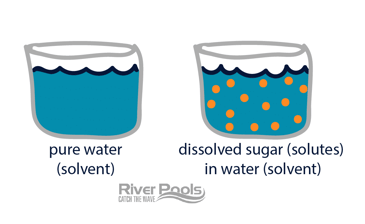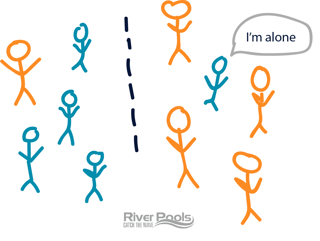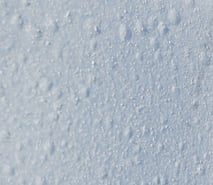
Double double, toil and trouble / fire burn and gelcoat bubble… Wait. Why are there bubbles in my pretty, pretty fiberglass pool gelcoat? How did they get there? Who can I yell at about it?
First of all, don’t yell. It’s not nice for anyone.
Second, let’s take a chill pill and discuss these bubbles—osmotic blisters.
We’re going to have a great talk:
- What is osmosis?
- What are osmotic blisters in a fiberglass pool?
- How do you avoid osmotic blisters in an inground fiberglass pool?
What is osmosis?
Quick overview of osmosis: Things be movin’.
Okay but for real, let’s take a look at the handy-dandy dictionary:
Movement of a solvent (such as water) through a semipermeable membrane into a solution of higher solute concentration that tends to equalize the concentrations of solute on the two sides of the membrane.
Oh goody. Big science words. How useful.
Solutes vs. solvents
For starters, a solute is something dissolved IN the solvent.
(Say “the solute’s in the solvent” five times fast. It’ll help you remember it, plus it sounds kind of silly. Don’t take yourself too seriously, my friend.)
If you dump a packet of sugar in a glass of water, the sugar is the solute, and the water is the solvent.

The semipermeable membrane
The semipermeable bit means some things (often a solvent) can pass in and out, but others can’t.
To continue the sugar water example, a semipermeable surface lets the water move back and forth but not the dissolved sugar.
Equalizing the concentration
Equal concentration is not equal quantity.
When you have different amounts of solutes on either side of a semipermeable membrane, the solvent (water) doesn't care much about keeping the same amount of water on both sides.
The priority is maintaining the same percentage (or ratio) of solvent to solutes on both sides.
Time for a funky analogy!
Water is like a supportive friend group.
Let's say four besties see another friend surrounded by strangers. She's clearly uncomfortable.

The ratio of blue friends to orange strangers is 4:1 on the left and 1:4 on the right. No good!
They can’t make the strangers leave, but they can dilute the concentration of strangers in the room.
So some of the friends go over to join her.

Now the ratio is 1:1 on the left and 1:1 on the right (4 friends and 4 strangers). Beautiful.
So that’s osmosis in the overarching, vaguely science-y sense.
Let’s talk about how it applies to fiberglass pools and gelcoats.
What are osmotic blisters in a fiberglass pool?
Some of the questions I myself asked when first learning about osmotic blisters:
- Does the water still go in through the gelcoat?
- Isn’t the gelcoat supposed to be nonporous?
- Does the water come in through the back of the pool shell?
- Why does everyone say “osmosis” like we just stepped out of science class?
Osmosis in the fiberglass pool gelcoat
The gelcoat is the semipermeable surface.
It lets some of the itsy-bitsy teeny-weeny water molecules pass through.
Note: that’s not the same as being porous the way a concrete pool is porous. Algae isn’t allowed through the gelcoat the way water is, so it can’t embed itself in the pool walls.
When all goes well, the water just filters in and out with no issues.
How solvents bubble out into a gelcoat blister
All the chopped fiberglass in the pool shell is applied with a resin so that it sticks in place. Your options are polyester resin and vinyl ester resin.
Unfortunately, our pal Polyester Resin can’t mind his own business. As water moves back and forth, he starts mixing with it.
So instead of just water (solvent) moving around, you have new solutes: water + elements of polyester resin. Noooo thanks.
These solutes can’t flow back out of the gelcoat—they have nowhere to go. They pile up like dirty laundry.
Translation: that side of the gelcoat becomes a solution. A concentrated solution.
So more water starts flowing in to lower the concentration. Uh-oh spaghettios.
This small area under the gelcoat fills up with water.
Gradually that gathered water separates the gelcoat layer from the next layer of chopped fiberglass. This produces visible bubbles.
Et voilà: osmotic blisters that no one asked for.

Osmosis on both sides of a fiberglass pool shell
There’s a little bit of good news, at least.
This is only surface-level stuff—it won’t damage the structure of the pool shell. Neither side of the pool shell is in danger of crumpling or falling apart.
“Neither side?” you say. “We weren’t talking about the outer side. We’re talking about the gelcoat side.”
But remember, you have water inside the pool, but you also have groundwater surrounding the pool. (This causes hydrostatic pressure and means you shouldn’t drain your pool.)
The difference is twofold:
- You don’t have a gelcoat on the side of the pool that deals with groundwater. If any solutes develop, they don’t get trapped. They just live their lives.
- Osmotic blisters are a mere cosmetic issue, so even if they do happen to develop on the other side, no worries. You won’t see them, and they won't hurt anything.
How do you avoid osmotic blisters in an inground fiberglass pool?
Vinyl ester resin doesn’t react with the water passing through the gelcoat. The water just does its thing without accidentally developing any solutes that build up and eventually bubble out with water.
Unfortunately, some businesses value quantity over quality, so they apply multiple layers of low-quality vinyl ester resins. Even 1% vinyl ester still counts as a vinyl ester resin. See how that could be misleading?
Here at River Pools, we apply a single layer of 100% vinyl ester resin behind the gelcoat. This provides the most effective protection, at the lowest cost to you. On every level of manufacturing, installation, and service, we prioritize product quality and customer satisfaction.
Do you have any other questions about the process of choosing the perfect fiberglass pool? Dive into our ebook, which includes all the details you’ll need to make the best decision for you and your family!
At River Pools we specialize in fiberglass pools. Get in touch with us, and we’ll be happy to help you on your pool journey!
Editor's Note: This article was originally written by Holly Jender on February 27, 2018 Any opinions expressed are those of the author. Any prices referenced were based on information that was readily available at the time.
River Pools is a brand of inground fiberglass pools produced in a manufacturing facility in Fortville, IN. While our expertise is in manufacturing fiberglass pools, we have access to a network of installers with expertise relating to project design, installation, and pool service. We often tap into this knowledge base and share information freely with homeowners, just like you, considering installing a swimming pool in your backyard.

